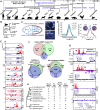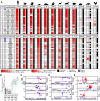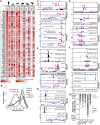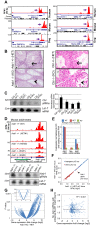Conserved piRNA Expression from a Distinct Set of piRNA Cluster Loci in Eutherian Mammals
- PMID: 26588211
- PMCID: PMC4654475
- DOI: 10.1371/journal.pgen.1005652
Conserved piRNA Expression from a Distinct Set of piRNA Cluster Loci in Eutherian Mammals
Abstract
The Piwi pathway is deeply conserved amongst animals because one of its essential functions is to repress transposons. However, many Piwi-interacting RNAs (piRNAs) do not base-pair to transposons and remain mysterious in their targeting function. The sheer number of piRNA cluster (piC) loci in animal genomes and infrequent piRNA sequence conservation also present challenges in determining which piC loci are most important for development. To address this question, we determined the piRNA expression patterns of piC loci across a wide phylogenetic spectrum of animals, and reveal that most genic and intergenic piC loci evolve rapidly in their capacity to generate piRNAs, regardless of known transposon silencing function. Surprisingly, we also uncovered a distinct set of piC loci with piRNA expression conserved deeply in Eutherian mammals. We name these loci Eutherian-Conserved piRNA cluster (ECpiC) loci. Supporting the hypothesis that conservation of piRNA expression across ~100 million years of Eutherian evolution implies function, we determined that one ECpiC locus generates abundant piRNAs antisense to the STOX1 transcript, a gene clinically associated with preeclampsia. Furthermore, we confirmed reduced piRNAs in existing mouse mutations at ECpiC-Asb1 and -Cbl, which also display spermatogenic defects. The Asb1 mutant testes with strongly reduced Asb1 piRNAs also exhibit up-regulated gene expression profiles. These data indicate ECpiC loci may be specially adapted to support Eutherian reproduction.
Conflict of interest statement
The authors have declared that no competing interests exist.
Figures






References
-
- Pasquinelli AE, Reinhart BJ, Slack F, Martindale MQ, Kuroda MI, Maller B, et al. Conservation of the sequence and temporal expression of let-7 heterochronic regulatory RNA. Nature. 2000;408(6808):86–9. Epub 2000/11/18. - PubMed
-
- Girard A, Sachidanandam R, Hannon GJ, Carmell MA. A germline-specific class of small RNAs binds mammalian Piwi proteins. Nature. 2006;442(7099):199–202. - PubMed
-
- Lau NC, Seto AG, Kim J, Kuramochi-Miyagawa S, Nakano T, Bartel DP, et al. Characterization of the piRNA complex from rat testes. Science. 2006;313(5785):363–7. - PubMed
Publication types
MeSH terms
Substances
Grants and funding
LinkOut - more resources
Full Text Sources
Other Literature Sources
Molecular Biology Databases
Miscellaneous

